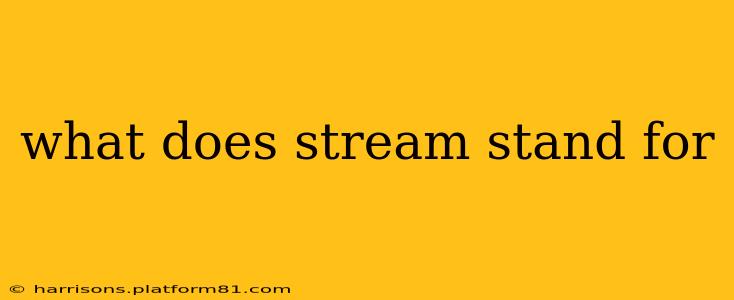What Does STREAM Stand For? Understanding the Diverse Meanings
The word "stream" doesn't have a single, universally accepted acronym. Instead, it's a word with multiple meanings, and depending on the context, it might be an abbreviation for different things. Let's explore some possibilities and the contexts where they apply:
1. In the Context of Data and Technology:
This is where you'll find the most common interpretations of "STREAM" as an acronym, though they are usually not explicitly defined as such in everyday usage. It's more accurate to say that the word "stream" itself describes the action of data flowing continuously. The following are relevant to the underlying concept of a continuous data flow.
-
Streaming Media: This is perhaps the most widely understood use. "Stream" here refers to the process of delivering multimedia content (audio, video) over the internet in a continuous flow, rather than downloading a complete file first. You're streaming a movie on Netflix, for example.
-
Data Streams: In computer science and data analysis, a data stream refers to a continuous flow of data. This is often used in real-time applications where data is constantly being generated and processed. Think of stock tickers, sensor data, or social media feeds.
2. Other Less Common Interpretations:
It's important to note that outside of the context of data and technology, "STREAM" rarely stands for anything. If you encounter it used as an acronym in a specific field or document, you'll need to look for further context within that document or field to understand the meaning.
3. Addressing Common Questions about Streaming:
Here are some frequently asked questions related to streaming, a common interpretation when someone searches for what "stream" stands for:
What is Streaming Media?
Streaming media involves delivering audio or video content over the internet in real time. Instead of downloading the entire file, users access it bit by bit as it's played. This allows for instant playback and reduces storage requirements. Platforms like Netflix, Spotify, YouTube, and Twitch all utilize streaming technology.
What are the Advantages of Streaming?
- Instant Access: No lengthy downloads are necessary.
- Lower Storage Requirements: Users don't need to store large files on their devices.
- Accessibility: Content can be accessed from various devices with an internet connection.
- Cost-Effectiveness: Subscription-based streaming services offer access to a vast library of content at a fixed monthly fee.
What are the Disadvantages of Streaming?
- Internet Dependency: A stable and reliable internet connection is crucial.
- Buffering Issues: Slow internet speeds or network congestion can cause interruptions.
- Data Consumption: Streaming can consume significant amounts of data, especially for high-definition content.
- Limited Offline Access: Many streaming services offer limited or no offline viewing options.
What are some Popular Streaming Services?
The landscape of streaming services is constantly evolving, but some of the most popular options include Netflix, Hulu, Amazon Prime Video, Disney+, Spotify, Apple Music, YouTube Premium, and Twitch.
In conclusion, while "STREAM" doesn't have a standard acronym definition, the word itself, particularly in the context of technology, strongly relates to the concept of a continuous flow of data, most famously associated with streaming media. Understanding the nuances of this concept is key to navigating the digital world.
